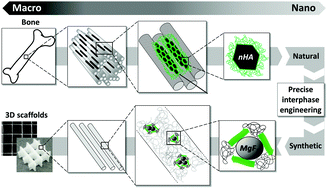Via precise interface engineering towards bioinspired composites with improved 3D printing processability and mechanical properties†
Abstract
Precise interface engineering in inorganic–organic hybrid materials enhances both the elastic moduli and toughness of a biodegradable composite, which is of relevance for load-bearing applications in bone tissue engineering. Tailor-made MgF2-binding peptide–polymer conjugates (MBC) are utilized as precision compatibilizers, having sequence-specific affinity for the surfaces of the inorganic MgF2 fillers to stabilize these particles and to contribute to the interactions with the continuous polymer matrix. The effects of the coupling agents are investigated in additively biomanufactured scaffolds from composites composed of MBC compatibilized magnesium fluoride nanoparticles (cMgF2) and poly(ε-caprolactone). Mechanical properties, degradation behavior, ion release kinetics and in vitro cell viability are positively influenced by the presence of the compatibilized nanoparticles cMgF2 compared to pure, non-compatibilized MgF2 (pMgF2). Mechanical tensile, compression and indentation experiments with single filaments as well as with scaffolds a reveal strong improvement of both elastic moduli and material toughness.



 Please wait while we load your content...
Please wait while we load your content...